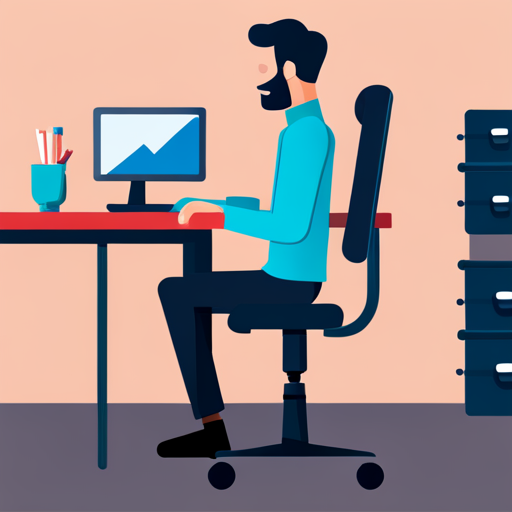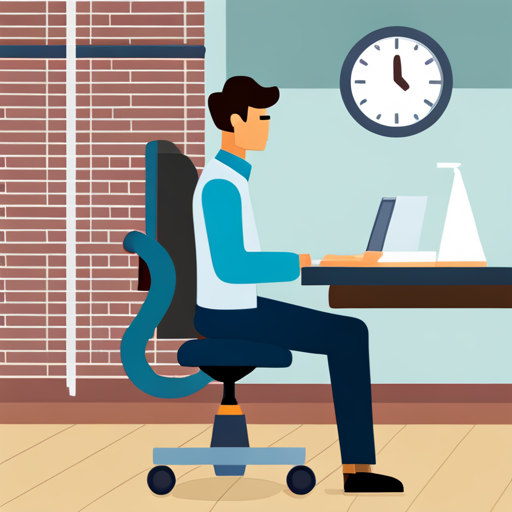Are you ready to dive into the mind-blowing world of office ergonomics? Brace yourself, because the impact it can have on your spinal health is absolutely mind-boggling!
Picture this: you’re sitting in your office chair, hunched over your computer, completely oblivious to the havoc you’re wreaking on your poor, unsuspecting spine. But fear not, my friend, because this article is here to save the day!
We’re about to unravel the secrets of proper chair height and posture, correct monitor placement, and ideal keyboard and mouse positioning.
Oh, and let’s not forget about the magical powers of stretching and exercise! Trust me, by the time you’re done reading, you’ll be armed with all the knowledge you need to transform your office into a spinal health haven.
So, get ready to bid farewell to back pain and say hello to a happier, healthier spine!
Key Takeaways
- Proper chair height and posture can reduce strain on the spine and prevent back pain.
- Good posture with relaxed shoulders and aligned spine supports spinal health.
- Correct monitor placement at eye level helps relieve neck and shoulder pain.
– Keyboard and mouse should be positioned to reduce strain and promote ease of use.
Understanding the Importance of Office Ergonomics

Imagine sitting at your desk, feeling your spine aligned perfectly, thanks to the magic of office ergonomics. Office ergonomics benefits go beyond just comfort. It creates an ergonomic workspace that promotes spinal health and overall well-being.
By adjusting your chair height and posture, you can reduce the strain on your spine and prevent back pain. A proper chair height ensures that your feet are flat on the floor, while maintaining a 90-degree angle at your knees. This helps to distribute your body weight evenly and reduces pressure on your lower back.
Additionally, maintaining good posture, with your shoulders relaxed and your spine aligned, further supports spinal health. So, let’s dive into the next section to learn more about proper chair height and posture.
Proper Chair Height and Posture

Feeling discomfort and pain in your back? Ensure your chair is at the correct height and maintain good posture to alleviate these issues. Here are some tips to help you:
- Lumbar support: Make sure your chair has proper lumbar support to keep your lower back in the correct position.
- Chair height: Adjust your chair so that your feet are flat on the ground and your knees are at a 90-degree angle.
- Posture: Sit up straight with your shoulders relaxed and your back against the chair. Avoid slouching or leaning forward.
- Standing desks: Consider using a standing desk for intermittent periods throughout the day to reduce the strain on your spine.
Remember, maintaining proper chair height and posture is essential for spinal health.
Now, let’s move on to the next section about correct monitor placement and eye level.
Correct Monitor Placement and Eye Level

To prevent your neck from constantly being in agony, it’s crucial to position your monitor correctly and ensure it’s at eye level. Adjusting the height of your monitor is super important because it can help relieve neck and shoulder pain.
When your monitor is too low, you end up hunching over and straining your neck. But when it’s at eye level, you can keep your head and neck in a more relaxed position. So, make sure to raise or lower your monitor so that the top of the screen is at eye level. By doing this, you’ll be able to work for longer periods without feeling discomfort.
And speaking of comfort, let’s move on to the next section about keyboard and mouse positioning, so you can be super comfy while you work.
Keyboard and Mouse Positioning for Optimal Comfort

Now let’s focus on achieving optimal comfort by positioning your keyboard and mouse in a way that reduces strain and promotes ease of use.
It’s important to have proper wrist alignment when using your keyboard and mouse to prevent repetitive strain injuries. Make sure your keyboard is positioned at a height that allows your wrists to be straight and parallel to the floor. Avoid bending your wrists up or down while typing.
Your mouse should be placed next to your keyboard at the same height, allowing your arm to rest comfortably and your hand to move freely. By maintaining proper wrist alignment, you can reduce the risk of developing pain and discomfort in your wrists and hands. This will help you work more comfortably and efficiently.
Speaking of comfort, let’s move on to some stretching and exercise tips for spinal health.
Stretching and Exercise Tips for Spinal Health

Implementing regular stretching and exercise routines can greatly contribute to maintaining a healthy spine. Here are some simple tips to help you keep your spine in tip-top shape:
- Core strengthening exercises:
– Planks: Get on your hands and toes, keeping your body straight, like a plank. Hold for 30 seconds and repeat.
– Supermans: Lie on your stomach with your arms and legs extended. Lift your arms and legs off the ground as high as you can and hold for a few seconds. Repeat.
– Bridges: Lie on your back with your knees bent and feet flat on the ground. Lift your hips off the ground, keeping your shoulders and feet on the floor. Hold for a few seconds and lower down.
- Yoga for spinal health:
– Cat-cow stretch: Get on all fours and arch your back up like a cat, then drop your belly down like a cow. Repeat.
– Child’s pose: Sit back on your heels and fold forward, reaching your arms out in front of you. Hold for a few breaths.
Remember, incorporating these exercises into your daily routine can help keep your spine healthy and strong.
Frequently Asked Questions
How does poor office ergonomics affect spinal health in the long term?
Poor office ergonomics can have a big impact on your spine in the long run. It can lead to back pain and other problems. But don’t worry! There are exercises and prevention measures you can take to keep your spine healthy.
Are there any specific exercises that can help alleviate back pain caused by poor ergonomics?
To alleviate back pain caused by poor ergonomics, try doing exercises and stretches specifically designed for spinal health. These can help relieve tension, improve flexibility, and strengthen your back muscles.
Can using an ergonomic chair alone solve all spinal health issues related to office work?
No, just using an ergonomic chair alone won’t solve all your spinal health issues caused by office work. Ergonomic chairs have limitations. Consider alternative solutions such as proper posture, regular breaks, and stretching exercises.
Can office ergonomics also have an impact on other parts of the body, such as the neck or shoulders?
Yes, office ergonomics can cause neck strain and shoulder pain. For example, if your computer monitor is too high, you may have to strain your neck to see it, leading to discomfort.
What are some common signs that indicate poor office ergonomics are affecting spinal health?
If you have poor office ergonomics, your spine can suffer. Signs like back pain, stiffness, and discomfort are common. It’s important to sit with good posture to prevent these spinal problems.
Conclusion
So there you have it, folks! Taking care of your spine at work is super duper important.
Remember to sit up straight, adjust your chair to the right height, and place your monitor at eye level. And don’t forget about your keyboard and mouse too, make sure they’re in a comfy position.
Oh, and don’t be a couch potato, get up and stretch every now and then. Your spine will thank you! It’s like giving your backbone a big ol’ hug.
So go on, show your spine some love!
